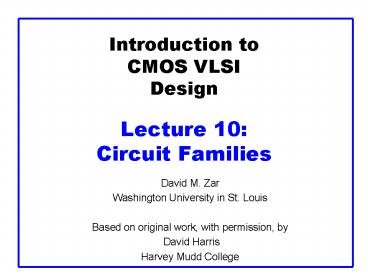Introduction to CMOS VLSI Design Lecture 10: Circuit Families - PowerPoint PPT Presentation
1 / 29
Title:
Introduction to CMOS VLSI Design Lecture 10: Circuit Families
Description:
Based on original work, with permission, by. David Harris. Harvey Mudd College ... Each domino gate triggers next one, like a string of dominos toppling over ... – PowerPoint PPT presentation
Number of Views:301
Avg rating:3.0/5.0
Title: Introduction to CMOS VLSI Design Lecture 10: Circuit Families
1
Introduction toCMOS VLSIDesignLecture 10
Circuit Families
David M. Zar Washington University in St.
Louis Based on original work, with permission,
by David Harris Harvey Mudd College
2
Outline
- Pseudo-nMOS Logic
- Dynamic Logic
- Pass Transistor Logic
3
Introduction
- What makes a circuit fast?
- I C dV/dt -gt tpd ? (C/I) DV
- low capacitance
- high current
- small swing
- Logical effort is proportional to C/I
- pMOS are the enemy!
- High capacitance for a given current
- Can we take the pMOS capacitance off the input?
- Various circuit families try to do this
4
Pseudo-nMOS
- In the old days, nMOS processes had no pMOS
- Instead, use pull-up transistor that is always ON
- In CMOS, use a pMOS that is always ON
- Ratio issue
- Make pMOS about ¼ effective strength of pulldown
network
5
Pseudo-nMOS Gates
- Design for unit current on output
- to compare with unit inverter.
- pMOS fights nMOS
6
Pseudo-nMOS Gates
- Design for unit current on output
- to compare with unit inverter.
- pMOS fights nMOS
7
Pseudo-nMOS Gates
- Design for unit current on output
- to compare with unit inverter.
- pMOS fights nMOS
8
Pseudo-nMOS Gates
- Design for unit current on output
- to compare with unit inverter.
- pMOS fights nMOS
9
Pseudo-nMOS Design
- Ex Design a k-input AND gate using pseudo-nMOS.
Estimate the delay driving a fanout of H - G
- F
- P
- N
- D
10
Pseudo-nMOS Design
- Ex Design a k-input AND gate using pseudo-nMOS.
Estimate the delay driving a fanout of H - G 1 8/9 8/9
- F GBH 8H/9
- P 1 (48k)/9 (8k13)/9
- N 2
- D NF1/N P
11
Pseudo-nMOS Power
- Pseudo-nMOS draws power whenever Y 0
- Called static power P IVDD
- A few mA / gate 1M gates would be a problem
- This is why nMOS went extinct!
- Use pseudo-nMOS sparingly for wide NORs
- Turn off pMOS when not in use
12
Dynamic Logic
- Dynamic gates uses a clocked pMOS pullup
- Two modes precharge and evaluate
13
The Foot
- What if pulldown network is ON during precharge?
- Use series evaluation transistor to prevent fight.
14
Logical Effort
15
Logical Effort
16
Monotonicity
- Dynamic gates require monotonically rising inputs
during evaluation - 0 -gt 0
- 0 -gt 1
- 1 -gt 1
- But not 1 -gt 0
17
Monotonicity Woes
- But dynamic gates produce monotonically falling
outputs during evaluation - Illegal for one dynamic gate to drive another!
18
Monotonicity Woes
- But dynamic gates produce monotonically falling
outputs during evaluation - Illegal for one dynamic gate to drive another!
19
Domino Gates
- Follow dynamic stage with inverting static gate
- Dynamic / static pair is called domino gate
- Produces monotonic outputs
20
Domino Optimizations
- Each domino gate triggers next one, like a string
of dominos toppling over - Gates evaluate sequentially but precharge in
parallel - Thus evaluation is more critical than precharge
- HI-skewed static stages can perform logic
21
Dual-Rail Domino
- Domino only performs noninverting functions
- AND, OR but not NAND, NOR, or XOR
- Dual-rail domino solves this problem
- Takes true and complementary inputs
- Produces true and complementary outputs
22
Example AND/NAND
- Given A_h, A_l, B_h, B_l
- Compute Y_h A B, Y_l (A B)
23
Example AND/NAND
- Given A_h, A_l, B_h, B_l
- Compute Y_h A B, Y_l (A B)
- Pulldown networks are conduction complements
24
Example XOR/XNOR
- Sometimes possible to share transistors
25
Leakage
- Dynamic node floats high during evaluation
- Transistors are leaky (IOFF ? 0)
- Dynamic value will leak away over time
- Formerly miliseconds, now nanoseconds!
- Use keeper to hold dynamic node
- Must be weak enough not to fight evaluation
26
Domino Summary
- Domino logic is attractive for high-speed
circuits - 1.5 2x faster than static CMOS
- But many challenges
- Monotonicity
- Leakage
- Charge sharing (see text)
- Noise (see text)
- Widely used in high-performance microprocessors
27
Pass Transistor Circuits
- Use pass transistors like switches to do logic
- Inputs drive diffusion terminals as well as gates
- CMOS Transmission Gates
- 2-input multiplexer
- Gates should be restoring
28
LEAP
- LEAn integration with Pass transistors
- Get rid of pMOS transistors
- Use weak pMOS feedback to pull fully high
- Ratio constraint
29
CPL
- Complementary Pass-transistor Logic
- Dual-rail form of pass transistor logic
- Avoids need for ratioed feedback
- Optional cross-coupling for rail-to-rail swing

